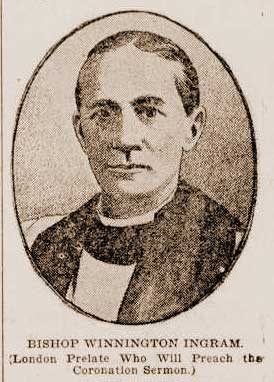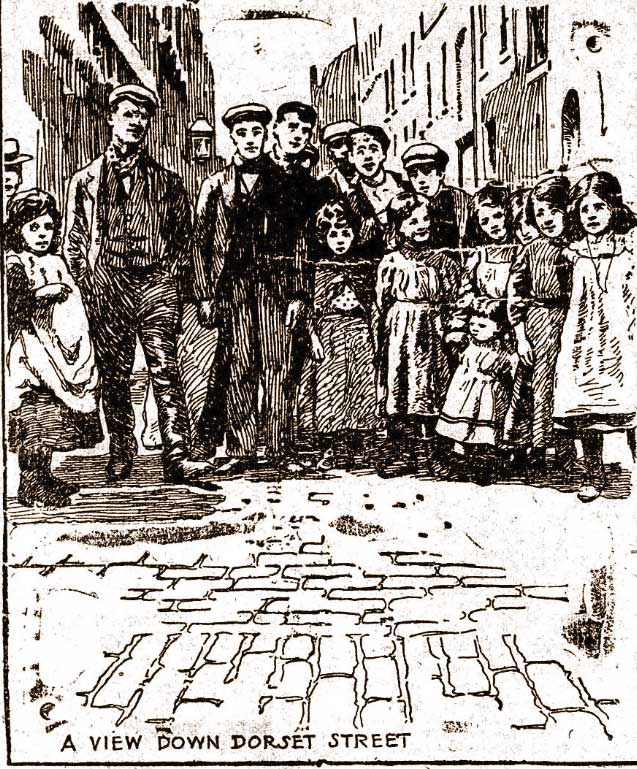Arthur Foley Winnington-Ingram (1858 – 1946) was Bishop of London from 1901 to 1939.
Prior to that, he had been a vicar in Bethnal Green, followed by a stint as the rural dean of Spitalfields.
When, in April 1902, it was reported that he had been chosen to give the sermon at the Coronation of King Edward Vll, originally scheduled for June 26th 1902, but then postponed until 9th August 1902, newspapers began looking closely at his career and providing readers with a glimpse of the kind of man he was.
The following biography of him appeared in The Defiance Express – an American newspaper – on the 14th of April, 1902:-
POPULAR IN LONDON.
No Man Has More Friends Than Bishop Winnington Ingram.
There are several eminent and dignified English prelates who have not yet recovered from the shock they sustained when the announcement was made recently that Very Rev. Winnington Ingram – better-known as the “slum bishop” – had been selected by King Edward to preach at his coronation.
There was a rather similar feeling of astonishment in the same quarter when, the post of Bishop of London having been made vacant by the death of Dr. Creighton a year ago, Ingram, who was looked upon as a mere youth, was named as his successor; for although the formal appointment was as usual made by Lord Salisbury, it was generally understood that the king had expressed a decided wish in the matter.

BECAME BISHOP OF LONDON
At the time of his promotion to the bishopric of London, which is one of the most important in the Church of England, Dr. Ingram occupied the post of suffragan bishop of Stepney, the last of the several ecclesiastical positions which he has held in the “East End” and in discharging the duties of which he endeared himself as perhaps no other clergyman in London to the wretched folks who live there.
A POOR AND WICKED PLACE
Stepney, like Bethnal Green, of which Dr. Ingram formerly was rector, and Spitalfields, of which he once was rural dean, is one of the poorest – and wickedest – divisions of Whitechapel, but Dr. Ingram was just as proud of his parishioners as if they had been the greatest aristocrats in Mayfair.
He was not merely their Bishop, he was their friend: and nothing used to delight him more than to be right among them as man to man.
TRIPS TO THE SEASIDE
Work among the men and boys was his greatest hobby and he formed several “social clubs” that became rather famous and, half the time, he was off on excursions to the country or the seashore with a grimy but exultant contingent of his “young barbarians” from Brick Lane or Houndsditch, giving them, perhaps, the first glimpse they ever had of the ocean or of green fields.
OPEN AIR SERVICES
He often held open-air services in the slums, notably in the large open space in front of Christchurch, Spitalfields, almost across the road from the entrance to Dorset Street, where several of the “Ripper” murders took place, and which is known as “the wickedest street in London.”

A MAN OF THE PEOPLE
Ever since he was raised to the dignity of the Bishop of London, at the request of the poor people who are so fond of him and so loath to give him up, the divine, whose office entitles him to sit in the House of Lords, made a visit to the East side, and, standing in his white surplice in the middle of a big crowd of shabby coster boys, factory, girls and mothers with unwashed babies in their arms, preached them a sermon of which the lowest of them could understand every word.
He used jestingly to tell his “poor people” how busy attending to his various parochial duties kept him, and delighted them by picturing himself hurrying to an appointment on top of a halfpenny bus or tramcar, or eating his lunch in a third-class carriage on the underground.
HE WOULD GIVE THEM A LIFT!
In the course of a little talk which he gave at the opening of a “reformed public house” in the East End the other day, he said that the additional duties that had come to him with his new position were so numerous that he had to set up a carriage, so they would miss him from the bus tops, but he promised that if any one of them who saw him driving in his new equipage would hail him and explain that he was one of his old friends he would be glad to give him a lift.
He added that many East End saloons had signs describing them as a “good pull-up for carters.” and suggested that over the “reformed club” be placed one saying “a good pull-up for Bishops.”
A MUSCULAR CHRISTIAN
It is no wonder that Dr. Ingram has been able to make even some of the toughest citizens of Spitalfields respect and esteem him, for he is the embodiment of “muscular Christianity.”
His favourite recreations are not chess and botany, but golf and bicycling and playing handball, or “fives,” as it is called in England.
The first sight that struck the eye on entering the bishop’s former headquarters at “Amen Court,” near St. Paul’s Cathedral, was a bundle of muddy golf clubs and a tennis racquet, and at historic Fulham Palace. which is his episcopal residence as Bishop of London, Dr. Ingram has set aside a large room in the cellar to play “fives” in.
